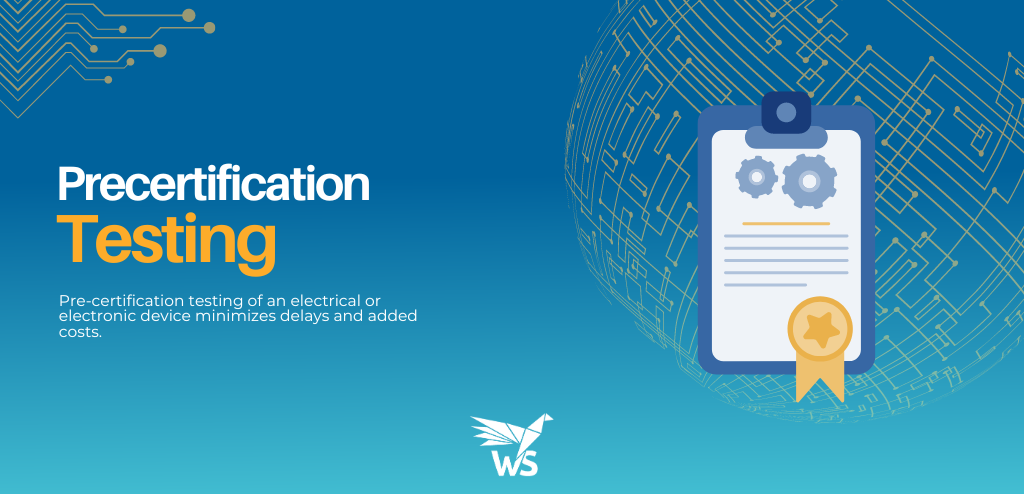- Pre-certification testing of an electrical or electronic device minimizes delays and added costs.

Any electrical or electronic product to be launched on the market must be tested according to the standards applicable to the country or countries where it is to be marketed. If, for example, we want to market in Europe, we must obtain the CE marking. If we want to do so in the United States, we must obtain the FCC marking. Or UKCA if the product is designed for the UK market.
Each standard (CE, FCC, UKCA…) has its own particularities and requirements. At WoodSwallow, we know the main standards in detail and our team of engineers can perform a wide range of pre-certification tests. During testing, our testing and design teams analyze the faults found and propose corrective actions. This is essential to eliminate problems during final certification testing in accredited laboratories. As a result, we are able to significantly reduce the financial costs and potential delays associated with device failures during certification. In short, pre-certification can save us a lot of headaches.
Main markings:
One of the most extended and well-known is the CE marking. This is the one that a wide variety of products must have to be marketed in the European Union. This marking shows that the manufacturer has evaluated the product and that it meets the safety, health and environmental protection requirements demanded by the EU. As it is very demanding, many countries outside the EU (e.g. in Asia or Africa) allow products to be marketed with the CE marking.
UKCA (UK Conformity Assessed) is a new marking that was created as a result of BREXIT. It must be displayed on products marketed in Great Britain (England, Wales, and Scotland). It is mandatory from January 2023 and replaces the CE marking that had been used until then. In general, it has many similarities with the CE marking.
On the other hand, FCC certification is a mandatory certification in the United States. It is regulated by the Federal Communications Commissions (FCC). It applies to all electrical or electronic equipment that generates an electromagnetic disturbance in its environment and wants to be marketed in the United States. This certification ensures that all EMC, Radio and RF exposure requirements are in compliance with US regulations.
Steps for the certification of an electrical or electronic device:
Any manufacturer seeking to place a product on the market must first obtain the appropriate marking. However, this process is usually long and complex. Sometimes even more complex than the design and manufacture of the product itself. At WoodSwallow we assist our clients and advise them to make this process as fast and efficient as possible.
The first step towards certification is located in the requirements definition phase (the phase prior to product design). In this phase, among other things, the requirements, and limitations to be met by each product in the market or markets of choice must be analyzed and considered in the following phases. This may limit the choice of components, PCB design or enclosure characteristics, among others.
Once the design process has started, the testing team must work hand in hand with the hardware design team. Once a device has a first version, a battery of tests must be carried out to detect possible problems from the start.
Most commonly, these tests will reflect a number of errors or flaws. These will be corrected as the product is modified, retested, and improved again until it is considered capable of meeting the necessary standards.
Last steps towards certification:
Once the development of the product is complete, the user manual is prepared. This is a mandatory document (in many cases) that must be provided by the manufacturer. It will contain all the information on how to use the product, how to install it, precautions to be considered, etc.
Once these stages have been completed, it is time to go to an official certification laboratory. There we hand over the final product, as well as the user manual and specify the market or markets in which we want to commercialize the product. This phase is crucial and will be the one that confirms that all the previous work has been carried out correctly. If the product does not pass any of the tests, our testing team will help to analyze all the viable options, prioritizing those in which the redesigns or modifications are the least costly possible.
If everything proceeds correctly, the laboratory will provide a set of documents (reports) on the tests performed and their results. In addition, the manufacturer will sign a declaration of conformity. This is a document stating that the product is in conformity with the relevant applicable legal requirements. In addition, it includes the main product and manufacturer data as well as the directives it complies with. Only then (in the case of the European Union) can the CE marking be affixed, and the product be placed on the market.
Some of the directives we work with on a regular basis:
There is a wide variety of standards and directives at both national and international level that are updated periodically and cover the different types of products that can be marketed in a specific market. WoodSwallow has more than 450,000 hours of experience in pre-certification testing and certification of electrical and electronic products. Below are some of the directives we work with most frequently:
Measuring Instrument Directive 2014/32/UE
The Measuring Instrument Directive, known as MID, establishes the requirements that measuring devices and systems (such as water, electricity, or gas meters) must meet in order to be marketed in the European Union. The tests required by this directive require very specific instrumentation, which is why not many companies are able to carry them out.
At WoodSwallow we have access to the required instrumentation which allows us to assess the regulatory compliance of our clients’ metering systems. Among others, we analyze compliance with the EN 50470-1 standard, which indicates the general requirements that class A, B and C measuring equipment must meet.
Low Voltage Directive 2014/35/UE (LVD)
The Low Voltage Directive (LVD) is a European directive that ensures that all electrical equipment within certain voltage limits offers a high level of protection to the public. Specifically, it covers equipment operating at an input or output voltage of between 50 and 1000 volts for alternating current, and between 75 and 1500 volts for direct current. It applies to a wide range of electrical equipment such as household appliances, machinery, or electrical installations.
To ensure that a device complies with the LVD, a battery of different types of tests are carried out, most of which are highly focused on safety. For example, drop tests are carried out to ensure that the device does not break on impact and that potentially dangerous elements, such as moving mechanical parts, remain inaccessible.
The glowing/hot-wire test, on the other hand, seeks to ensure that the materials of which it is composed are safe. In other words, that in the event of fire they are not combustible and do not burn, or that they do not drip. Another test that we carry out at WoodSwallow related to this directive is the dielectric strength test whose objective is to check the intrinsic safety of the designed device, ensuring that, among other things, the safety distances (clearance and creepage) are complied with.
Electromagnetic Compatibility Directive (EMC) 2014/30/EU
This should be one of the most well-known directives for companies designing electrical or electronic devices as they all must comply with it. The EMC directive aims to guarantee the correct functioning of the device, as it will be affected by an electromagnetic environment that is often saturated with other devices and highly variable, such as a home, an office, a factory, etc.
It is one of the most problematic directives and one that causes the most cost overruns. Despite this, it is one of the most ‘forgotten’ by manufacturers. For this reason, we always recommend taking this regulation into account from the very beginning to avoid costly problems when certifying. Our team has extensive experience in this field, both in design and testing, and has access to laboratory equipment capable of performing most of them. In addition, our experience allows us to offer different approaches to solving a problem. Sometimes a solution can be found by simply modifying the firmware; making it more robust or moving the operating frequency, to give a few examples.
One of the tests we carry out within the framework of this directive is the radiated emissions test. This involves specific equipment and installations, such as spectrum analysers, signal receivers or anechoic chambers. This equipment needs qualified personnel with extensive experience, as they are expensive and fragile devices whose results can easily be misinterpreted. In addition to executing such tests correctly, our engineers can identify sources of failure in the event that they occur. To this end, on-site modifications are often carried out to check what the source of the problem is and whether these modifications have resolved the problem.
Radio Equipment Directive 2014/53/EU
The Radio Equipment Directive 2014/53/EU (known as RED) establishes a regulatory framework for placing on the market and putting into service radio equipment in the European Union. That is, equipment that emits or receives radio waves for communication or radiolocation purposes. This directive applies to more and more devices as the current trend is to replace wired communications with radio communications.
Devices that have not traditionally used this type of communication, such as domestic energy meters, are being brought up to date with this technology and must therefore comply with the RED standard to be launched on the European market.
For a correct testing of radio-containing equipment, it is necessary to be aware of the latest technologies in use and even future technologies, as constant updating is one of the characteristics of the standards in this directive.
Our team, made up mainly of electronics and telecommunications engineers, is trained in established technologies such as Wi-Fi and Bluetooth. We are also committed to continuous training and updating our laboratory equipment to stay at the forefront of new technologies, such as 5G, in order to anticipate our customers’ needs.
In conclusion, considering pre-certification testing in the development process of your electrical or electronic product is a smart decision that will help you avoid problems when it comes to obtaining certification to market your product. If you have any doubts on this subject, contact us and our specialized team will be happy to answer them.






